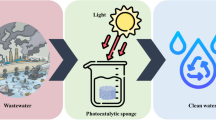Abstract
The anaerobic degradability of alcohol ethoxylates with various degrees of branching and several related substances was studied. Different inocula were employed in order to increase the probability of obtaining capable bacteria, and the degradation assays were fed with several small doses of the test substances in order to avoid inhibition by too high initial concentrations. Mineralization was quantified by monitoring the biogas production and inorganic carbon concentration in the liquid phase. Almost complete mineralization was achieved in the assays with linear alcohol ethoxylate, poly(ethylene glycol), dodecanol, 2-ethyl-hexanoic acid and 3-methyl-valeric acid. No significant degradation was detected in the assays with highly branched alcohol ethoxylate, 2-butyl-branched alcohol ethoxylate, alcohol alkoxylate, poly(propylene glycol) and iso-tridecanol. A 2-ethyl-branched alcohol ethoxylate was transformed to (2-ethyl-hexyloxy)-acetate, which was not further degraded. Apparently already the first step of anaerobic degradation of alcohol ethoxylates, the ethoxylate chain shortening, is sterically hindered by the alkyl branching. Alkyl branching in alcohol ethoxylates and the inclusion of propylene oxide units in alcohol alkoxylates seem to have a clearly more detrimental effect on anaerobic degradability than on aerobic degradability.
Similar content being viewed by others
References
Álvarez JA, Zapico CA, Presas J, Ruíz I & Soto M (2001) Anaerobic treatment and pretreatment of municipal wastewater at low ambient temperature. In: van Velsen AFM & Verstraete WH (Eds) Proceedings of the 9th World Congress on Anaerobic Digestion, Antwerpen, Vol 2 (pp 425–427)
Battersby NS, Kravetz L & Salanitro JP (2000) Effect of branching on the biodegradability of alcohol-based surfactants. In: Proceedings of the 5th World Surfactants Congress, Florence, Italy (pp 1397–1407)
Dwyer DF & Tiedje JM (1986) Metabolism of polyethylene glycol by two anaerobic bacteria, Desulfovibrio desulfuricans and a Bacteroides sp. Appl. Environ. Microbiol. 52: 852–856
ECE (2000) Nonylphenol risk reduction strategy. Final Report. Commission of the European Communities, Brussels. http://europa.eu.int/comm/enterprise/chemicals/markrestr/studies/nonylphenol.pdf
ERASM (1999) Anaerobic biodegradation of surfactants. Report of the Environmental Risk Assessment Steering and Management Committee, Brussels. http://www.aise-net.org/PDF/anaerobicBiopubl.pdf
Field JA (2002) Limits of anaerobic biodegradation. Water Sci. Technol. 45: 9–18
Frings J, Schramm E & Schink B (1992) Enzymes involved in anaerobic polyethylene glycol degradation by Pelobacter venetian us and Bacteroides strain PG 1. Appl. Environ. Microbiol. 58: 2164–2167
Huber M, Meyer U & Rys P (2000) Biodegradation mechanisms of linear alcohol ethoxylates under anaerobic conditions. Environ. Sci. Technol. 34: 1737–1741
Kawai F (2002) Microbial degradation of polyethers. Appl. Microbiol. Biotechnol. 58: 30–38
Kravetz L, Salanitro JP, Dorn PB & Guin KF (1991) Influence of hydrophobe type and extent of branching on environmental response factors of non ionic surfactants. J. Am. Oil Chem. Soc. 68: 610–618
Marcomini A, Pojana G, Carrer C, Cavalli L, Cassani G & Lazzarin M (2000) Aerobic Biodegradation of monobranched aliphatic alcohol polyethoxylates. Environ. Toxicol. Chem. 19: 555–560
Mösche M & Meyer U (2001) Anaerobe Reinigung tensidhaltiger Abwiisser der Textilveredlungsindustrie. Chem. Ing. Technol. 73: 1639–1643
Naylor CG, Castaldi FJ & Hayes BJ (1988) Biodegradation of nonionic surfactants containing propylene oxide. J. Am. Oil Chem. Soc. 65: 1669–1675
Salanitro JP & Diaz LA (1995) Anaerobic biodegradability testing of surfactants. Chemosphere 30: 813–830
Sin SN & Chua H (2000) Degradation pathway of persistent branched fatty acids in natural anaerobic ecosystem. Chemosphere 41: 149–153
Steber J & Wierich P (1987) The anaerobic degradation of detergent range fatty alcohol ethoxylates. Studies with 14C-labelled model surfactants. Water Res. 21: 661–667
Stieb M & Schink B (1986) Anaerobic degradation of isovalerate by a defined methanogenic coculture. Arch. Microbiol. 144: 291–295
Varadaraj R, Bock J, Zushma S, Brons N & Colletti T (1991) Effect of hydrocarbon branching on interfacial properties of monodisperse ethoxylated alcohol surfactants. J. Colloid Interface Sci. 147: 387–395
Wagener S & Schink B (1988) Fermentative degradation of nonionic surfactants and polyethylene-glycol by enrichment cultures and by pure cultures of homoacetogenic and propionate-forming bacteria. Appl. Environ. Microbiol. 54: 561–565
Author information
Authors and Affiliations
Corresponding author
Rights and permissions
About this article
Cite this article
Mösche, M. Anaerobic Degradability of Alcohol Ethoxylates and Related Non-Ionic Surfactants. Biodegradation 15, 327–336 (2004). https://doi.org/10.1023/B:BIOD.0000042188.10331.61
Issue Date:
DOI: https://doi.org/10.1023/B:BIOD.0000042188.10331.61




